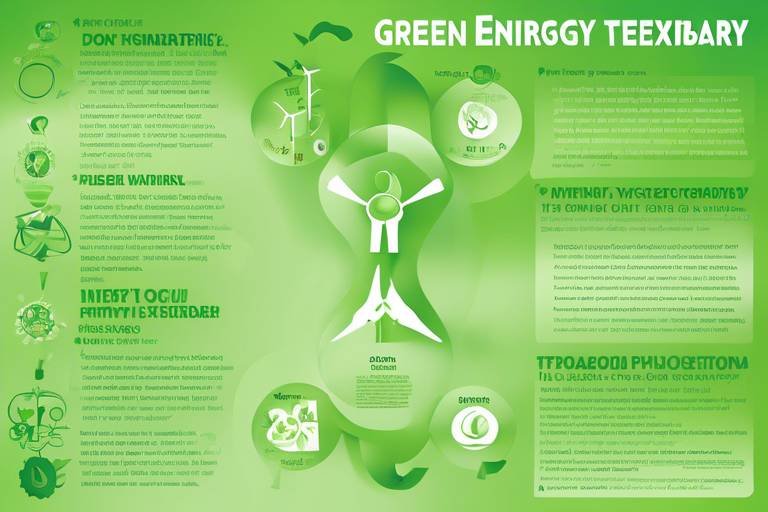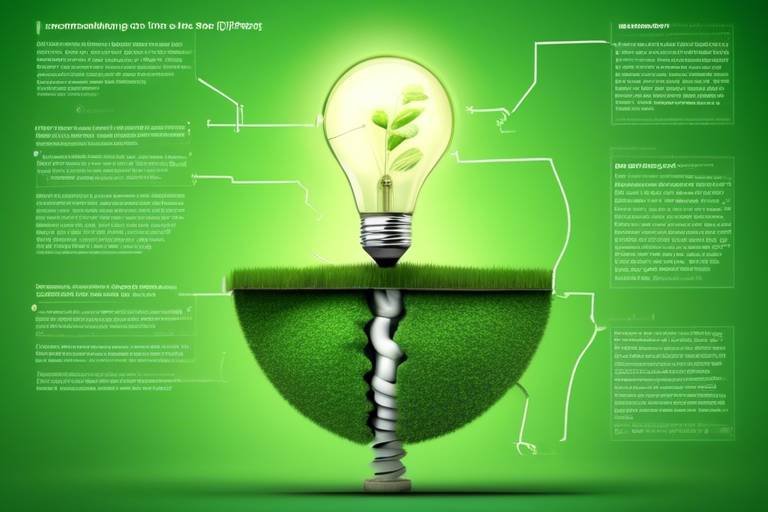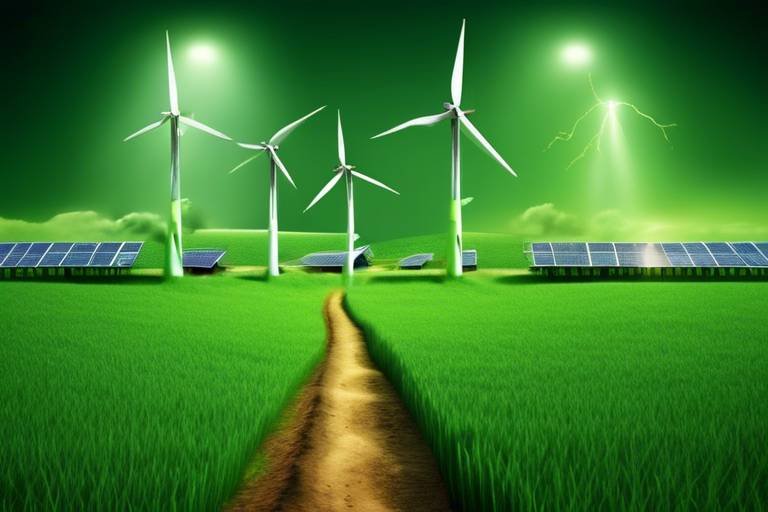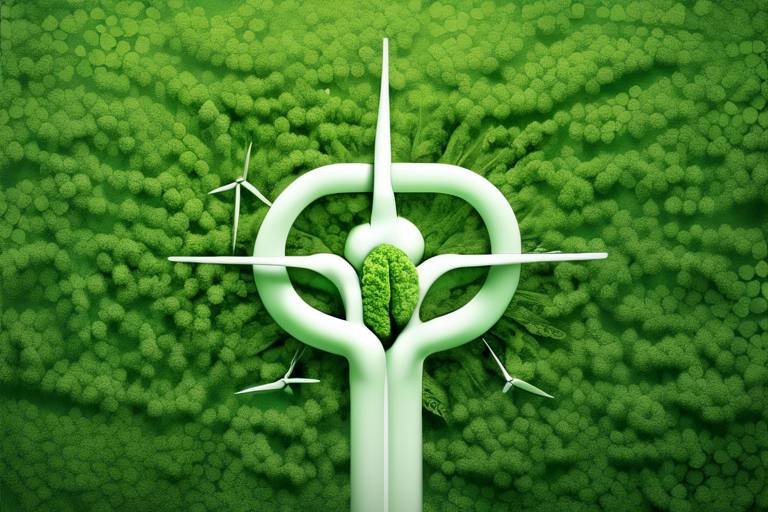How to Build a Green Energy Playground
Creating a green energy playground is not just about fun and games; it’s about fostering a sense of environmental responsibility among children while providing them with a space to explore and learn. Imagine a playground where children can swing, slide, and climb, all powered by the sun and the wind! This article will guide you through the essential steps and considerations for building a playground that harnesses renewable energy, promotes environmental awareness, and provides a fun learning experience for children.
First off, let’s dive into what we mean by green energy. This term encompasses renewable energy sources such as solar, wind, and hydro, which have minimal environmental impact compared to fossil fuels. Incorporating green energy into playground design is crucial for several reasons:
- Environmental Impact: Using renewable energy helps reduce carbon footprints and promotes sustainability.
- Community Benefits: Green energy can lower operational costs and encourage community involvement.
- Educational Opportunities: Children learn about sustainability and the importance of protecting our planet.
By utilizing green energy, playgrounds can become beacons of sustainability, inspiring the next generation to prioritize environmental conservation.
Choosing the right location for your green energy playground is crucial. Think about accessibility: is it easy for families to get there? Consider the environmental impact of the site; you want to minimize disruption to local wildlife and ecosystems. Additionally, engage with the community to understand their needs and desires. A successful playground should be a reflection of the community it serves, ensuring it meets the needs of children and families alike.
Integrating renewable energy sources like solar panels and wind turbines is essential for powering playground features. When selecting these technologies, consider the following:
| Energy Source | Benefits | Considerations |
|---|---|---|
| Solar Panels | Low maintenance, sustainable energy | Requires sunlight; initial cost |
| Wind Turbines | Generates energy in windy areas | Noise and aesthetic concerns |
By carefully selecting and installing these technologies, playgrounds can significantly reduce their reliance on non-renewable energy sources, creating a more sustainable environment for play.
Using sustainable materials is vital for a green playground. Look for eco-friendly options such as recycled plastics, sustainable wood, and non-toxic paints. The durability of these materials ensures they can withstand the wear and tear of energetic play while keeping children safe. Remember, safety is paramount, so always prioritize materials that meet safety standards while being kind to the planet.
A green energy playground should be more than just a place to play; it should educate children about sustainability. Incorporate design elements that encourage interaction and learning. For instance, consider adding:
- Interactive displays: Teach kids about energy production and conservation.
- Nature trails: Promote exploration and appreciation for the environment.
- Workshops: Offer hands-on experiences related to renewable energy.
By fostering a sense of environmental responsibility among young visitors, you can inspire them to become stewards of the planet.
Engaging the community in the planning process is essential for the success of your green energy playground. Host meetings to gather input, secure funding through local grants or partnerships, and ensure local support for the project. When the community feels invested, they are more likely to take ownership and care for the playground, making it a cherished space for years to come.
Ongoing maintenance is crucial for the longevity of a green playground. Establish best practices for maintaining equipment and energy systems. Regular inspections, cleaning, and repairs will ensure sustainable operation over time. Additionally, consider involving local schools or community groups in maintenance efforts, turning upkeep into a learning opportunity.
Examining existing green energy playgrounds provides valuable insights. For example, the Green Play Project in California integrates solar power and educational displays, successfully engaging the community and promoting sustainability. These case studies can serve as inspiration for new projects, demonstrating that with creativity and commitment, a green energy playground can thrive.
Q: What are the initial costs associated with building a green energy playground?
A: While the initial investment may be higher due to renewable energy technologies and eco-friendly materials, the long-term savings on energy costs and maintenance can offset these expenses.
Q: How can we involve children in the design process?
A: Organize workshops or brainstorming sessions where children can share their ideas for the playground. This involvement fosters a sense of ownership and excitement about the space.
Q: What are some examples of eco-friendly materials?
A: Recycled plastics, sustainably sourced wood, and non-toxic paints are excellent choices for creating a safe and environmentally friendly playground.

Understanding Green Energy
Green energy is more than just a trendy phrase; it's a vital part of our future. When we talk about green energy, we're diving into the world of renewable sources like solar, wind, and hydro power. These sources are not only abundant but also have a minimal environmental impact compared to traditional fossil fuels. Imagine harnessing the sun's rays or the wind's gentle breeze to power our daily lives—how cool is that? This section will explore why incorporating green energy into playground design is essential and how it benefits our communities.
First off, let's consider the environmental benefits. By utilizing renewable energy, we significantly reduce greenhouse gas emissions, which are a major contributor to climate change. This is crucial for our planet's health and the well-being of future generations. Think of it as planting a tree: it not only benefits you today but also creates a better environment for tomorrow. In playgrounds, using green energy can help teach children the importance of sustainability and environmental stewardship.
Moreover, green energy can lead to substantial cost savings in the long run. While the initial investment in solar panels or wind turbines may seem daunting, the reduction in utility bills can make a huge difference over time. Many communities have found that investing in renewable energy not only pays off financially but also enhances the playground experience. For instance, playgrounds powered by solar energy can operate lights, interactive displays, and other features without relying on traditional electricity sources.
Now, you might be wondering, "How does this all tie into playground design?" Well, a green energy playground serves as an educational platform where children can learn about energy sources and their impact on the environment. Imagine kids playing on swings powered by solar energy or engaging in games that teach them about wind turbines. This hands-on experience can spark curiosity and inspire the next generation of environmentalists.
To illustrate the significance of green energy, let's take a look at the comparison between traditional energy sources and renewable ones:
| Energy Source | Environmental Impact | Cost Efficiency | Longevity |
|---|---|---|---|
| Fossil Fuels | High emissions, pollution | Variable, often rising costs | Finite resources |
| Solar Energy | Minimal emissions | Decreasing costs, long-term savings | 25+ years lifespan |
| Wind Energy | Minimal emissions | Decreasing costs, long-term savings | 20+ years lifespan |
| Hydro Energy | Minimal emissions | Stable costs, long-term savings | 50+ years lifespan |
In summary, understanding green energy is crucial for anyone looking to create a sustainable playground. It not only helps the environment but also provides a unique educational opportunity for children. By embracing these renewable sources, we can build playgrounds that are not just fun but also serve as a beacon of hope for a greener future. So, let’s get inspired and start thinking about how we can incorporate these elements into our playground designs!

Site Selection and Planning
When it comes to creating a green energy playground, the site selection and planning phase is nothing short of crucial. Imagine you’re setting the stage for a vibrant environment where children can learn about sustainability while having fun. The first step is to identify a location that not only meets the community's needs but also maximizes the potential for renewable energy usage. Think about it: the right site can transform a simple playground into a hub of environmental education and innovation!
Accessibility is a key factor in site selection. You want to ensure that children, parents, and caregivers can easily reach the playground. This means considering proximity to schools, residential areas, and public transportation. A well-placed playground encourages more foot traffic and allows for spontaneous visits, which can foster a sense of community. Furthermore, environmental impact is another critical consideration. Before making a decision, conduct an environmental assessment to understand the local ecosystem. This will help you avoid areas that are home to protected species or vital habitats.
Another aspect to think about is the topography of the chosen site. Flat land is often ideal for playgrounds, as it allows for safer equipment installation and easier accessibility. However, incorporating natural features like hills or trees can enhance the play experience. For instance, a gentle slope can create a fun slide or climbing area, while trees can provide shade and a natural aesthetic. You might even consider using these natural elements to power your playground—think solar panels on a roof or wind turbines on a hill!
In addition to environmental and accessibility factors, it’s essential to engage with the community during the planning process. Hosting community meetings can gather input on what features are most desired. This not only ensures that the playground meets local needs but also fosters a sense of ownership and pride among community members. After all, when people feel involved, they’re more likely to support and maintain the playground in the long run.
As you move forward with your planning, it’s beneficial to create a site plan that outlines the layout of the playground. This plan should include:
- Play equipment locations
- Paths and accessibility routes
- Green energy installations, such as solar panels and wind turbines
- Seating areas for caregivers
- Natural landscaping features
By carefully considering these elements, you can design a playground that not only serves its purpose as a play area but also acts as a beacon of sustainability and education. The right site selection and planning can ultimately lead to a successful green energy playground that captivates the hearts and minds of children while promoting a healthier planet.

Incorporating Renewable Energy Sources
When it comes to creating a green energy playground, is not just an option; it's a necessity. Imagine a playground where the swings are powered by the sun, and the slides are illuminated by wind energy! This vision can become a reality with the right approach to integrating renewable technologies. Solar panels and wind turbines are the two primary sources that can be harnessed to energize playground features while also providing an educational experience for children.
First, let's dive into solar energy. Solar panels, or photovoltaic cells, can be installed on structures like shade canopies or nearby buildings. These panels convert sunlight into electricity, which can then power lights, interactive displays, or even small water features like fountains. Not only do these installations reduce reliance on traditional energy sources, but they also serve as a fantastic teaching tool about how solar energy works. Kids can see firsthand how energy is generated and stored, sparking curiosity and discussions about sustainability.
Next, we have wind energy. Wind turbines, though often associated with large farms, can also be scaled down for playground use. Small, vertical-axis wind turbines can be integrated into the playground's design. These turbines can generate energy to power playground equipment or charge batteries for nighttime lighting. Imagine a child watching a turbine spin in the breeze, learning about wind energy while enjoying their time on the playground. It’s a perfect blend of fun and education!
Integrating these renewable sources requires careful planning and consideration. Here are some key points to keep in mind:
- Location: Ensure that solar panels are placed where they receive maximum sunlight, and wind turbines are positioned in areas with adequate wind flow.
- Safety: All installations must adhere to safety regulations to protect children and ensure that the equipment is durable and secure.
- Maintenance: Regular checks and maintenance of the energy systems are essential to keep them functioning optimally.
Moreover, it's important to engage with local energy experts and environmental engineers during the planning phase. They can provide insights on the best technologies suited for your specific location and community needs. By doing so, you can create a playground that not only meets safety standards but also maximizes energy efficiency and educational value.
In addition to solar panels and wind turbines, consider incorporating other innovative technologies. For instance, kinetic energy systems can be installed in playground equipment, allowing children to generate energy through their movements. Imagine a merry-go-round that powers lights as kids spin around! This not only makes playtime more exciting but also teaches children about energy generation through motion.
Ultimately, the goal of incorporating renewable energy sources in a playground is to create a sustainable environment that fosters learning and encourages children to think about their impact on the planet. By making renewable energy a core component of your playground design, you are not just building a place for play; you are creating a space for environmental stewardship and community engagement.
Q: How much energy can solar panels generate for a playground?
A: The amount of energy generated depends on the size and efficiency of the solar panels, as well as the amount of sunlight received. A well-placed solar panel system can significantly reduce energy costs and power playground features.
Q: Are wind turbines safe for children?
A: Yes, when properly installed and maintained, small wind turbines are safe for playground environments. They should be designed with safety features to prevent accidents.
Q: Can renewable energy sources be used in all climates?
A: While solar panels are effective in sunny areas, wind turbines can be beneficial in windy regions. It's essential to assess the local climate to determine the best renewable energy solutions.
Q: How can we educate children about the renewable energy technologies used in the playground?
A: Incorporating informative signage, interactive displays, and guided tours can help educate children about how solar and wind energy work, fostering a deeper understanding of sustainability.

Eco-Friendly Materials and Equipment
When it comes to building a green energy playground, the choice of eco-friendly materials and equipment is paramount. Not only do these materials contribute to a sustainable environment, but they also ensure the safety and durability needed for children’s play areas. Imagine a playground where every swing, slide, and climbing frame is crafted from materials that are as kind to the planet as they are fun for kids. It's like giving Mother Nature a high-five while providing a safe space for children to explore and learn!
One of the most popular choices for eco-friendly playground equipment is recycled plastic. This material is not only durable but also resistant to weathering, making it an ideal choice for outdoor installations. Recycled plastic can be used for benches, play structures, and even safety surfacing. Another excellent option is wood from sustainably managed forests. This natural material adds warmth and beauty to the playground while ensuring that the wood is sourced responsibly. The charm of wooden structures can ignite a child’s imagination, transforming a simple climbing frame into a pirate ship or a castle!
It's also essential to consider the safety aspects of the materials used. Many eco-friendly options come with certifications that ensure they meet safety standards. For instance, non-toxic paints and finishes are crucial for protecting children from harmful chemicals. When selecting paints and coatings, look for products labeled as low-VOC (volatile organic compounds) or water-based, as these are less harmful to both children and the environment.
In addition to materials, the playground's surfacing plays a significant role in safety. Traditional materials like asphalt and concrete can be harsh and unsafe for children. Instead, consider using natural grass, rubber mulch, or recycled tires for a softer landing. These options not only cushion falls but also contribute to a more eco-friendly environment. For example, rubber mulch made from recycled tires is a fantastic choice as it is durable, drains well, and reduces the need for chemical treatments that are common with traditional grass.
To visualize the impact of these materials, let’s take a look at a comparison table that highlights some common playground materials and their eco-friendly alternatives:
| Traditional Material | Eco-Friendly Alternative | Benefits |
|---|---|---|
| Concrete | Recycled Rubber | Cushions falls, drains water, environmentally friendly |
| Wood (unsustainable) | Sustainable Wood | Durable, beautiful, responsibly sourced |
| Plastic (virgin) | Recycled Plastic | Durable, weather-resistant, reduces landfill waste |
| Traditional Paints | Low-VOC Paints | Non-toxic, safer for children and the environment |
In conclusion, choosing eco-friendly materials and equipment for a green energy playground is not just about sustainability; it’s about creating a safe, engaging, and beautiful environment for children. By opting for recycled materials, sustainably sourced wood, and non-toxic finishes, we can build playgrounds that are not only fun but also serve as a model for environmental responsibility. So, the next time you’re planning a playground, think green – your community and the planet will thank you!
- What are eco-friendly materials? Eco-friendly materials are those that are sustainable, recyclable, and have minimal impact on the environment.
- Why is it important to use eco-friendly materials in playgrounds? Using eco-friendly materials helps reduce environmental impact, promotes sustainability, and ensures the safety of children playing in the playground.
- Can recycled materials be safe for children? Yes, many recycled materials are specifically designed to meet safety standards for playground equipment and surfacing.
- What types of equipment can be made from sustainable materials? Equipment such as swings, slides, climbing frames, and benches can all be made from eco-friendly materials.

Designing for Education and Engagement
When it comes to creating a green energy playground, the design should not only be visually appealing but also serve as a dynamic learning environment for children. Imagine a place where kids can play while simultaneously absorbing knowledge about sustainability and the importance of renewable energy. It's like turning a playground into a living classroom! By integrating educational elements into the design, we can foster a sense of environmental responsibility that lasts a lifetime.
One effective way to achieve this is by incorporating interactive features that engage children in hands-on learning experiences. For instance, consider installing solar-powered games that teach kids about solar energy through play. These games could include solar panels that light up when children engage with them, allowing them to see firsthand how sunlight can be converted into energy. This direct interaction not only makes learning fun but also instills a sense of wonder about how energy works.
Another innovative design element could be the use of wind turbines integrated into the playground's structure. These turbines can serve as both a functional energy source and an educational tool. Children can learn about wind energy by watching the turbines spin, and perhaps even engage in activities where they can measure wind speed and understand how it contributes to energy generation. This hands-on approach demystifies complex concepts and makes them accessible to young minds.
Moreover, consider creating themed zones within the playground that focus on different aspects of sustainability. For example, you might have a water conservation zone with splash pads that use recycled water, teaching kids about the importance of conserving this precious resource. Each zone can be equipped with informative signs or interactive displays that provide fun facts and challenges, encouraging children to explore and learn as they play.
To further enhance engagement, you could also incorporate a community garden where children can learn about growing their own food. This not only promotes healthy eating habits but also teaches kids about the importance of local ecosystems and biodiversity. Imagine the joy of planting seeds and watching them grow, all while understanding the role of plants in our environment!
In addition to these features, it’s essential to involve children in the design process. Hosting workshops where kids can share their ideas about what they would like to see in their playground can lead to a sense of ownership and pride. This involvement can be as simple as drawing their dream playground or as complex as helping to design certain interactive elements. By giving them a voice, we not only engage them but also empower them to take an active role in their environment.
In conclusion, designing a green energy playground with education and engagement in mind transforms playtime into a rich learning experience. By integrating interactive elements, themed zones, and community involvement, we can create a space that not only entertains but also educates. Let’s inspire the next generation to become stewards of the earth, all while having a blast!
- What is a green energy playground? A green energy playground is a play area that utilizes renewable energy sources like solar and wind power, designed to educate children about sustainability.
- How can children learn about sustainability in a playground? Through interactive features such as solar-powered games, wind turbines, and community gardens, children can engage in hands-on learning experiences.
- Why is community involvement important in the design process? Engaging the community ensures that the playground meets local needs and fosters a sense of ownership among residents, which is essential for the project's success.
- What materials are used in eco-friendly playgrounds? Sustainable materials like recycled plastics, natural wood, and non-toxic finishes are commonly used to ensure safety and durability.

Community Involvement and Support
Creating a green energy playground is not just about the design and the technology; it's about the community that will use it. Engaging local residents, parents, and children in the planning process is essential for building a playground that truly meets the needs of its users. Imagine a playground that not only entertains but also educates – a place where children can learn about sustainability while having fun. This vision can only come to life with the support and involvement of the community.
To kick off the project, consider hosting community meetings where residents can voice their ideas and concerns. This not only builds a sense of ownership but also allows for a diverse range of perspectives to be heard. You might be surprised at the wealth of knowledge and creativity that exists within your community! Engaging local schools can also be a fantastic way to gather input, as students often have fresh and innovative ideas. Plus, involving kids in the design process can create excitement and anticipation for the playground.
Another important aspect of community involvement is securing funding. Many local governments and organizations offer grants for projects that promote sustainability and community engagement. By demonstrating that your project has community support, you can increase your chances of receiving these funds. Consider creating a fundraising committee made up of passionate community members who can help organize events, seek sponsorships, and apply for grants. This collaborative effort not only raises money but also fosters a deeper connection among community members.
Once the playground is built, ongoing community support is vital for its success. Establishing a volunteer program can encourage residents to take part in maintenance and events, ensuring that the playground remains a safe and enjoyable space. Regular community clean-up days or educational workshops can keep the community engaged and invested in the playground’s upkeep. The more people feel connected to the playground, the more likely they are to take care of it.
Ultimately, the success of a green energy playground hinges on how well it reflects the needs and desires of the community. By actively involving residents in every step of the process, from planning to maintenance, you create a vibrant space that not only serves as a recreational area but also as a hub for environmental education and community bonding. It’s this sense of community that transforms a simple playground into a cherished local landmark.
- How can I get my community involved in the playground project? Hosting community meetings, engaging local schools, and forming a fundraising committee are excellent ways to involve residents.
- What types of funding are available for green playgrounds? Look for local government grants, sponsorships from businesses, and community fundraising events.
- How can we maintain community interest after the playground is built? Organize regular events, clean-up days, and educational workshops to keep the community engaged.

Maintenance and Sustainability Practices
When it comes to ensuring the longevity and effectiveness of a green energy playground, maintenance is not just a task; it's a commitment to sustainability. Keeping the playground in top shape not only enhances the experience for children but also reinforces the principles of environmental stewardship that the playground embodies. Regular maintenance checks are essential to identify any wear and tear on equipment, ensuring safety and functionality. This entails inspecting playground structures, energy systems, and eco-friendly materials regularly. Imagine a playground that’s not only fun but also a beacon of sustainability; it’s essential to keep that light shining bright!
One of the key aspects of maintenance is the upkeep of renewable energy systems. Solar panels, for instance, require periodic cleaning to ensure optimal performance. Dust, leaves, and debris can accumulate, blocking sunlight and reducing energy output. Regularly scheduled inspections can help detect issues early, allowing for timely repairs. Similarly, wind turbines should be checked for any mechanical issues or damage from weather conditions. Why not think of these systems as the playground's heart? Just like we need to take care of our own hearts, these systems need attention to keep pumping energy into the playground.
Moreover, sustainability practices extend beyond just maintenance. It’s about creating a culture of care within the community. Engaging local volunteers for maintenance days can foster a sense of ownership and pride. Hosting workshops on how to care for the playground and its energy systems can empower community members, turning them into stewards of the environment. This collaborative spirit not only maintains the playground but also strengthens community ties.
In addition to regular maintenance, it's crucial to establish a sustainability plan that outlines best practices and procedures for ongoing care. This plan should include:
- Routine inspections and maintenance schedules for equipment and energy systems.
- Guidelines for the use of eco-friendly cleaning products to maintain safety and sustainability.
- Education programs for staff and volunteers about the importance of sustainability in maintenance practices.
- Strategies for monitoring energy output and usage to optimize performance.
By integrating these practices, the playground can serve as a living example of sustainability in action. Parents and children alike will appreciate the effort put into maintaining a safe and environmentally friendly space. Furthermore, documenting maintenance activities can provide valuable insights for future projects, showcasing the effectiveness of sustainable practices.
In summary, the maintenance of a green energy playground is a multifaceted endeavor that requires attention, community involvement, and a commitment to sustainability. By prioritizing regular maintenance and fostering a culture of care, we can ensure that these playgrounds not only thrive but also inspire future generations to embrace environmental responsibility.
Q: How often should maintenance be performed on the playground?
A: Regular inspections should be conducted at least once a month, with more thorough checks performed quarterly or biannually.
Q: What should we do if we notice damage to the playground equipment?
A: Any damage should be reported immediately to the maintenance team, who can assess the situation and make necessary repairs.
Q: Can community members get involved in maintenance efforts?
A: Absolutely! Engaging volunteers for maintenance days not only helps with upkeep but also builds community spirit.
Q: Are there specific cleaning products that are recommended for eco-friendly maintenance?
A: Yes, it’s best to use biodegradable and non-toxic cleaning products to ensure the safety of children and the environment.

Case Studies of Successful Projects
When it comes to building a green energy playground, learning from successful projects can be incredibly insightful. These case studies not only highlight innovative designs but also showcase effective community engagement strategies that can serve as inspiration for your own project. Let's dive into a couple of standout examples that embody the spirit of sustainability and education.
One remarkable project is the Solar-Powered Playground in San Francisco. This playground integrates solar panels into its design, providing power for lighting, interactive educational displays, and even charging stations for electric scooters and bikes. The community was heavily involved in the planning stages, ensuring that the playground met the needs of local families. The result? A vibrant space that not only entertains children but also teaches them about renewable energy. The playground has become a hub for environmental education, with workshops and events focused on sustainability.
Another inspiring example is the Wind Energy Playground in Chicago. This playground features small wind turbines that generate electricity for various activities, including a splash pad and climbing structures. The project was funded through a combination of community fundraising and local government grants, showcasing the power of collaboration. Children are encouraged to learn about wind energy through interactive displays, making it an educational experience as much as it is recreational. The playground has greatly increased community interest in renewable energy, leading to further initiatives aimed at sustainability in the area.
| Project Name | Location | Key Features | Community Involvement |
|---|---|---|---|
| Solar-Powered Playground | San Francisco | Solar panels, educational displays, charging stations | High community engagement in planning |
| Wind Energy Playground | Chicago | Wind turbines, splash pad, climbing structures | Funded through community efforts and grants |
These case studies illustrate that a green energy playground is not just about the equipment; it’s about creating a community-focused space that promotes education and sustainability. By integrating renewable energy sources and engaging the local community in the planning process, these projects have successfully fostered a sense of environmental responsibility among children and their families.
Additionally, these playgrounds have shown that the benefits extend beyond just fun and games. They have become vital educational tools, sparking conversations about renewable energy and environmental stewardship. As communities continue to explore the possibilities of green energy playgrounds, these successful projects serve as beacons of innovation and collaboration.
- What are the main benefits of a green energy playground? Green energy playgrounds promote sustainability, educate children about renewable energy, and foster community engagement.
- How can a community get involved in the planning of a green energy playground? Communities can hold meetings, conduct surveys, and collaborate with local organizations to gather input and support.
- What types of renewable energy sources can be used in playgrounds? Common sources include solar panels, wind turbines, and even small hydro systems, depending on the location.
- Are green energy playgrounds more expensive to build? While initial costs may be higher, the long-term savings from reduced energy costs and the benefits of community engagement often outweigh the investment.
Frequently Asked Questions
- What is a green energy playground?
A green energy playground is a recreational area designed to utilize renewable energy sources like solar and wind power. It not only provides a fun space for children but also promotes environmental awareness and sustainability.
- Why is it important to use green energy in playground design?
Using green energy in playground design minimizes environmental impact and sets a positive example for children. It teaches them about renewable resources, fostering a sense of responsibility towards the planet.
- How do I choose the right location for a green energy playground?
Consider factors like accessibility, environmental impact, and community needs when selecting a location. A good site ensures that the playground is used effectively and serves the community's interests.
- What renewable energy sources can be incorporated into a playground?
Common renewable energy sources for playgrounds include solar panels and wind turbines. These can power playground features like lights and educational displays, enhancing the sustainability of the area.
- What materials should be used for a green playground?
Opt for eco-friendly materials such as recycled plastics, sustainably sourced wood, and non-toxic finishes. These materials are not only better for the environment but also ensure safety and durability for children.
- How can a green energy playground educate children?
Design elements that encourage interaction, like educational signs about renewable energy, can engage children. Play structures that demonstrate energy concepts can make learning fun and impactful.
- How can the community get involved in the planning process?
Engaging the community can be done through surveys, public meetings, and workshops. Gathering input helps ensure the playground meets local needs and secures support for the project.
- What maintenance practices are essential for a green playground?
Regular inspections of equipment and energy systems are crucial. Keeping solar panels clean and ensuring wind turbines are functioning properly helps maintain the playground's sustainability over time.
- Can you share examples of successful green energy playgrounds?
Yes! There are several case studies showcasing innovative designs and community engagement. These examples can serve as inspiration for new projects, highlighting what works well in real-world settings.



















